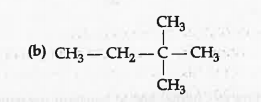Complete Solutions to EXCERSICE of chapter Solved Paper 2020-1 of Class 11 book with complete answers and questions
| Class 11 | CHEMISTRY |
| Chapter | Solved Paper 2020-1 |
| OSWAAL PUBLICATION | EXCERSICE |
| Number Of Questions | 51 |
| Academic Year | 2023-24 |
What is the S.I. unit of volume?
01:06View SolutionWrite the mathematical expression for Boyle's law.
03:36View Solutionwrite the equilibrium constant in term of concentration `A+BharrC+D` equilibrium equation.
01:43View SolutionGive the general electronic configurations of 'd' block elements.
00:44View SolutionWhat is the oxidation state of oxygen in peroxide i.e.`H2O2`?
03:31View SolutionAlkali Metlas are soft metals why?
02:20View SolutionWhat type of hybridization does carbon undergo in diamond and graphite ?
01:32View SolutionWhat is Catenation?
03:12View SolutionExpand the IUPAC.
01:39View SolutionWrite the general formula of alkynes.
02:21View SolutionIf the density of some lake water is 1.2.5 g `mL^(-1)` and contains 92 g of `Na^(+)` ions per kg of water, calculate the molality of `Na^(+)` ions in the lake.
02:25View SolutionDefine visocity of a liquid.
02:05View SolutionState Charle's law. Give the mathmatical expression.
02:23View SolutionHow is ethyl bromide converted into ethylbenzene by Friedel - Crafts reactions ? Give the equations.
02:30View SolutionWurtz reaction using bromoethane yields
01:54View SolutionName the components of photochemical smog.
02:18View SolutionWhat is ionisation energy? How does ionisation energy vary along the period in the modern periodic table ?
02:39View SolutionWrite any three postulates of Molecular orbital theory.
06:28View SolutionExplain `SP^2` hybridisation in ethene molecule.
10:14View SolutionGive any two difference between `sigmaandpi` bond.
02:40View SolutionBalance the following redox reaction by half reaction method.
`Fe^(2+)(aq)+Cr_(2)O_(7)^(2-)(aq)toFe^(3+)(aq)+Cr^(3+)(aq)` (In acid medium)06:17View SolutionExplain the laboratory preparation of dihydrogen.
04:17View SolutionGive any three differences between lithium and other akali metals.
04:00View SolutionExplain the structure of diamond giving the reason for its harness as well as non conductivity of electricity.
04:05View SolutionA compound contains 4.07% hydrogen,24.27% carbon and 71.65% chlorine.Its molar mas is 98.96 g.What are its empirical formula and molecular formula?
12:30View SolutionWhat is ter molecular reaction ? Give an example.
02:52View SolutionSummarize the Bohr's Model of an atom.
04:15View SolutionWhat are isotopes?Give an example.
04:13View SolutionWrite the significance of four quantum numbers.
04:32View SolutionWho discovered neutron?
01:30View SolutionWrite any four postulates of kinetic theory of gases
02:41View SolutionWhat is an ideal gas?
03:45View SolutionThe standard entropy change `Delta S_r^@` for
`CH_(4(g)) + 2O_(2(g)) to CO_(2(g)) + 2H_2O_((l))`
is -242.98 `JK^(-1)` at `25^@C`. Calculate the standard reaction enthalpy for the above reaction if standard Gibbs energy of formation of `CH_(4(g)), CO_(2(g)) and H_2O_((l))` are -50.72, -394.36 and - 237.13 kJ `mol^(-1)` respectively.04:39View SolutionCalculate the enthalpy of formation of methanol from the following data,
`CH_(3)OH(l) + (3)/(2)O_(2)(g) rarr CO_(2)(g) + 2H_(2)O(l) ….(i) " "Delta H^(@) = -726.4 kJ mol^(-1)`
`C"(graphite)" + O_(2)(g) rarr CO_(2)(g) ….(iii) " "Delta H^(@) = -393.5 kJ mol^(-1)`
`H_(2)(g) + (1)/(2)O_(2)(g) rarr H_(2)O(l) ....(iii) " "Delta H^(@) = -285.8 kJ mol^(-1)`.04:08View SolutionCalculate the enthalpy of formation of methanol from the following data,
`CH_(3)OH(l) + (3)/(2)O_(2)(g) rarr CO_(2)(g) + 2H_(2)O(l) ….(i) " "Delta H^(@) = -726.4 kJ mol^(-1)`
`C"(graphite)" + O_(2)(g) rarr CO_(2)(g) ….(iii) " "Delta H^(@) = -393.5 kJ mol^(-1)`
`H_(2)(g) + (1)/(2)O_(2)(g) rarr H_(2)O(l) ....(iii) " "Delta H^(@) = -285.8 kJ mol^(-1)`.04:08View SolutionWhat is an isolated system ?
02:56View SolutionWhat is an intensive property? Give an example.
01:43View SolutionWhat is entropy?Given its unit.
02:58View SolutionWhat is an endothermic reaction ? Give an example.
03:08View SolutionExplain Bronsted-Lowry concept of Acid and Base.
05:36View SolutionWhat is conjugate acid and conjugate base for `NH_3`?
01:56View SolutionWrite the relationship between `K_p` and `K_c`
03:31View SolutionCalculate the ph of 0.001 `MH_2SO_4`
04:55View SolutionDefine buffer action.
01:58View SolutionWhat is hydronium ion?
04:03View SolutionHow sulphur is estimated by Carius method and give calculation.
03:22View SolutionWhat is Frenkel defect? Give an example.
03:14View SolutionDefine a homologous series of carbon compounds, List any two characteristics of a homologous series.
03:40View SolutionWrite the IUPAC Name.

 04:55View Solution
04:55View SolutionExplain the mechanism of addition of HBr to propene with equations.
09:05View SolutionHow do you convert benzene into benzene hexachloride (BHC)?
04:36View Solution
EXCERSICE questions and complete solutions for chapter Solved Paper 2020-1 of OSWAAL PUBLICATION of Class 11
